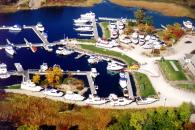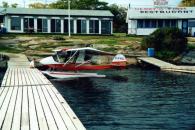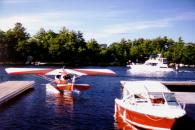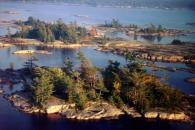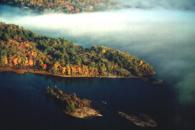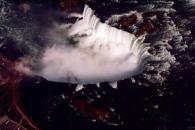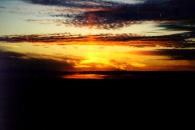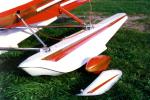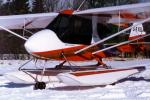|
It's November and snow squalls are coming in off Georgian Bay. XSL is still on its Puddlejumper amphibs, squeezing the last drops out of the float season. I've become quite addicted to the joys of flying around on amphibs in such a pleasurable little airplane as the Challenger. Here are some vignettes from my first autumn. Some are short, some are longer. There isn't room for them all. SEPT. 21, BUTTONVILLE On the last day of summer my ten year old son Nathan and I take XSL to display at the Buttonville Airport Open House. We taxi up to the cordoned-off exhibit area where we are marshalled to our spot between two Cessna's, a Caravan on amphibs and a Citation. What a fine threesome we make: one for payload, one for speed and one for pleasure. Guess which is which! Someone asks if it's possible to tow an ultralight on floats behind
a cabin cruiser, like a dinghy. After the proverbial double-take we crank around in a steep one-eighty and land beside the impossible. We shut down and chat with the strangers for a while. It turns out the ultralight pilot spotted his friend's boat and landed to visit. The airplane's just tied to the anchored vessel so it won't drift away in the current. Whew! SEPT. 25, LITTLE LAKE I spot some strange new objects near the western shore of Little Lake and head over to investigate. They turn out to be duck blinds, with hunters shivering miserably inside and decoys bobbing woodenly outside. How fascinating: all the real ducks are congregated over by the eastern shore, safely out of range! I light the afterburners and exit the area post haste for fear I'll be mistaken for the biggest bird of the season. OCT. 13, SANS SOUCI It's the Sunday of Thanksgiving weekend and Henry's World Famous Fish Restaurant is about to close for the season. Nate and I head north to Sans Souci for lunch. Henry's is located on Frying Pan Island. Which came first: Frying Pan Island or the frying pan on the island? Give up? Actually, the restaurant opened after the island was named. What foresight on the part of the cartographers! Docking at Henry's, After a suitably fine lunch Nate and I head off, promising to come back in January when XSL is on skis and Henry's is open for the snowmobile set. OCT. 13, HONEY HARBOUR On the way home from Sans Souci, Nate wants to stop in at Honey Harbour. We fly up the harbour, pass the marina and restaurant, do a descending one-eighty, land, taxi in, shut-down, and drift to a stop right beside the gas attendant. All in one smooth continuous motion. The attendant, apparently impressed, in a reverent tone calls me Captain. Ah! Made my day! This is why we practise so much. "Nate, let's make the long line fast to that cleat over there
to hold the boat off when the wakes hit." "Dad, it's not a boat! It's an airplane!" "Oh yeah, right! Leave enough slack in the line "Dad! It's not a boat!" "Okay!" This Captain thing has gone to my head! The marina and restaurant at Honey Harbour are exposed to the monster wakes created by Winnebagos of Waterworld enroute to the exclusive yacht club up the harbour. The first time I docked here a sympathetic sailor took me under his wing, actually my wing, and showed me the ropes. Literally! Now I know how to secure the boat, oops, airplane, to ride out the nastiest of wakes. OCT. 16, THIRTY THOUSAND ISLANDS The fall foliage is at its peak. One good blow and it'll be all over. I decide to head up Georgian Bay to the Thirty Thousand Islands. My plan is to follow the route of the cruise ships. A ship's brochure will supplement my VFR Navigation Chart. I emerge from some tacky weather as I cross the shoreline of Severn Sound. Flight Service has assured me there won't be any fog, but I'm suspicious and decide to make sure I have an alternate at all times. We fly north toward Parry Sound. To the west is the water of Georgian Bay, the opposite shore too distant to be visible. The blue water mirrors the blue sky, rising and falling gently on relaxed swells, reminders of yesterday's wind. To the east is the Muskoka region, an endless carpet of red, orange and yellow, interspersed with pockets of dark green conifers and blue lakes. Separating east and west is the granite coast which passes under
us in the still air. Summer's over and the marinas and restaurant's have mostly closed. In four hours of flying I see less than a handful of boats. One I don't see has left a long straight black line, half the wake, moving undisrupted across the glassy water. The other half is now out of sight. I make several stops, turning off the engine to float in silence. At each stop I'm serenaded by a loon, presumably not the same one. The colours of the trees are reflected perfectly in the water. There is a certain Zen to this Challenger float flying! At the apex of the journey, over Parry Sound, Heading south, I realize that Twelve Mile Bay is the same length as Five Mile Bay, which is five miles long. The latter must have been named by a cartographer, the former by a fisherman. A loon in a small bay scrambles in a running take-off, flapping madly in an attempt to keep up. "Hey wait for me!" Then it gives up and lands, furiously back pedaling with wings and extending feet as water brakes. Crossing Severn Sound we slip back into the murk, transitioning into another universe. As I pass near Orr Lake, the sun reveals itself just above the horizon, a red ball slipping ever lower, painting a red stripe across the water. As I drive home in the darkness the unforecast fog thickens. OCT. 26, BARRIE My eight year old son Gregory and I are preflighting XSL when Bill Postil and Marc Marcil come by in their Challengers for a visit. After a chat we take off in a flight of three. This is Greg's first taste of formation flying. We fly south in formation for a while then peel away to check out the action in Kempenfelt Bay. It's pretty much deserted. All but one of the yachts at the club are up on shore wearing their winter blankets of blue saran wrap. We climb up to 2,000 feet to check the view from on high. Greg wants to do some soaring so I shut the engine off. The thermals have gone south for the winter, we do some gliding instead. We spiral silently down to a landing on Little Lake where we open the doors and chat for a while. We do a circuit with Greg following through on the controls. Throttle full forward, stick full back, up on the step, rotate, spiral up, shut off the engine, spiral back down in silence to touch down. Then it's back to the airport. Greg does all the banking, I help with pitch. He can't reach the pedals yet! Greg tells Nate enthusiastically about his flight. Nate clamors for his turn. OCT. 29, NIAGARA FALLS What's the second worst place to make a forced landing? On a field of lava from a Hawaiian volcano. Touchdown is instant incineration! What's the worst place for a forced landing? On the Niagara River, just upstream from Niagara Falls. Death is anything but instantaneous!
Today I'm circling the falls and even though XSL is on floats we're staying within gliding range of shore! NOV. 6, BARRIE There's a warm, wet, blustery wind from the south. It feels more like March than November. I head over to the airport to squeeze in a flight before sunset. The windsock is horizontal and pointing directly across the runway. The Challenger handles cross winds quite well, even on the amphibious floats. Nevertheless, I wouldn't want much more crosswind component than this. There's quite a bit of mechanical turbulence so I climb to see what it's like higher up. There's a sharply defined wind shear at 2,220 feet ASL. Above 2,220 feet it's as smooth as glass, below 2,220 feet it's definitely not. I explore the boundary for a while. It's so sharply defined you could use it to set your altimeter! At 4,000 feet I throttle back and head into the wind. The GPS ground speed readout is in the single digits. I chase my tail, doing steep three-sixties trying to fly through my own wake turbulence, getting a satisfying thump when I succeed.
The turbulence on short final is jolting to say the least, like being attacked by a jackhammer. The wind is roaring up the hill and curling over to the runway. It's mighty angry at having it's bottom shredded by buildings and trees. I carry extra energy and fly by the law of averages. The average airspeed and the average attitude are about right. Stick and rudder are in constant motion. The crab angle is absurd, I'm looking out the left window at the runway. A burst of power is required to arrest some sink as we come over the fence. Then it's time to round out and flare, kicking out the crab angle and lowering the upwind wing, wagging it to maintain our track along the centerline, dissipating the extra energy we carried. Touchdown is on one wheel, the main on the upwind float. XSL rocks in the wind as we taxi carefully off the runway and back to the hangar. NOV. 10, SNOW VALLEY I'm at home watching snow squalls through the window. A week ago
we had a foot of snow. Last week's snow is now gone, I called winter's bluff correctly. Today the snow is melting as it lands but I realize my time is just about up. I'd best get those skis on! Soon those soft reflections on the water will be only memories. For the next few months we're looking at sharp shadows cast on the winter snow by the bright sun. The bluest skies and best visibilities of the year are almost here. XSL will take off and climb like a rocket, and land anyplace white! I wonder if my first season on skis will be as memorable as my first season on floats?
To learn and see more order our comprehensive information package and video! |

